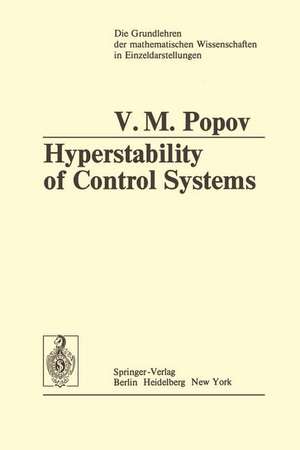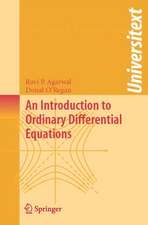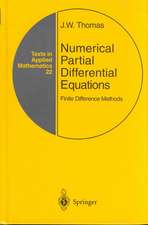Hyperstability of Control Systems: Grundlehren der mathematischen Wissenschaften, cartea 204
Autor Vasile M. Popov Traducere de Radu Georgescuen Limba Engleză Paperback – 21 noi 2011
Din seria Grundlehren der mathematischen Wissenschaften
-
 Preț: 353.84 lei
Preț: 353.84 lei - 24%
 Preț: 728.15 lei
Preț: 728.15 lei -
 Preț: 410.21 lei
Preț: 410.21 lei - 24%
 Preț: 587.87 lei
Preț: 587.87 lei - 17%
 Preț: 498.73 lei
Preț: 498.73 lei -
 Preț: 592.75 lei
Preț: 592.75 lei - 20%
 Preț: 692.49 lei
Preț: 692.49 lei - 24%
 Preț: 893.28 lei
Preț: 893.28 lei - 20%
 Preț: 824.73 lei
Preț: 824.73 lei - 24%
 Preț: 632.96 lei
Preț: 632.96 lei - 15%
 Preț: 596.69 lei
Preț: 596.69 lei - 15%
 Preț: 714.49 lei
Preț: 714.49 lei -
 Preț: 333.01 lei
Preț: 333.01 lei - 15%
 Preț: 473.16 lei
Preț: 473.16 lei -
 Preț: 356.49 lei
Preț: 356.49 lei -
 Preț: 484.43 lei
Preț: 484.43 lei - 15%
 Preț: 452.79 lei
Preț: 452.79 lei -
 Preț: 456.66 lei
Preț: 456.66 lei - 15%
 Preț: 708.75 lei
Preț: 708.75 lei -
 Preț: 423.08 lei
Preț: 423.08 lei - 15%
 Preț: 444.29 lei
Preț: 444.29 lei - 15%
 Preț: 527.79 lei
Preț: 527.79 lei - 15%
 Preț: 589.65 lei
Preț: 589.65 lei -
 Preț: 353.40 lei
Preț: 353.40 lei - 18%
 Preț: 727.66 lei
Preț: 727.66 lei -
 Preț: 387.96 lei
Preț: 387.96 lei - 15%
 Preț: 454.74 lei
Preț: 454.74 lei - 15%
 Preț: 481.03 lei
Preț: 481.03 lei -
 Preț: 464.55 lei
Preț: 464.55 lei -
 Preț: 348.77 lei
Preț: 348.77 lei -
 Preț: 362.04 lei
Preț: 362.04 lei -
 Preț: 488.12 lei
Preț: 488.12 lei - 15%
 Preț: 447.57 lei
Preț: 447.57 lei -
 Preț: 419.81 lei
Preț: 419.81 lei -
 Preț: 388.52 lei
Preț: 388.52 lei -
 Preț: 419.21 lei
Preț: 419.21 lei - 15%
 Preț: 581.01 lei
Preț: 581.01 lei -
 Preț: 497.75 lei
Preț: 497.75 lei -
 Preț: 360.53 lei
Preț: 360.53 lei -
 Preț: 387.75 lei
Preț: 387.75 lei -
 Preț: 419.81 lei
Preț: 419.81 lei - 18%
 Preț: 725.75 lei
Preț: 725.75 lei -
 Preț: 453.78 lei
Preț: 453.78 lei -
 Preț: 386.39 lei
Preț: 386.39 lei
Preț: 393.35 lei
Nou
Puncte Express: 590
Preț estimativ în valută:
75.27€ • 78.43$ • 62.32£
75.27€ • 78.43$ • 62.32£
Carte tipărită la comandă
Livrare economică 03-17 aprilie
Preluare comenzi: 021 569.72.76
Specificații
ISBN-13: 9783642656569
ISBN-10: 3642656560
Pagini: 404
Ilustrații: 400 p.
Dimensiuni: 152 x 229 x 21 mm
Greutate: 0.54 kg
Ediția:Softcover reprint of the original 1st ed. 1973
Editura: Springer Berlin, Heidelberg
Colecția Springer
Seria Grundlehren der mathematischen Wissenschaften
Locul publicării:Berlin, Heidelberg, Germany
ISBN-10: 3642656560
Pagini: 404
Ilustrații: 400 p.
Dimensiuni: 152 x 229 x 21 mm
Greutate: 0.54 kg
Ediția:Softcover reprint of the original 1st ed. 1973
Editura: Springer Berlin, Heidelberg
Colecția Springer
Seria Grundlehren der mathematischen Wissenschaften
Locul publicării:Berlin, Heidelberg, Germany
Public țintă
ResearchCuprins
1. Introduction.- 1. Stability as a property of a family of systems.- 2. The families of systems considered in the problem of absolute stability.- 3. Selecting the most natural families of systems.- 4. Introducing new families of systems.- 5. The concept of hyperstability.- 6. Indications on the use of the monograph.- 2. Classes of Equivalent Systems.- § 1. Equivalence classes for quadratic forms with relations between the variables.- § 2. Classes of single-input systems.- § 3. The characteristic polynomial of single-input systems.- § 4. Conditions under which all systems with the same characteristic polynomial belong to the same class.- § 5. Equivalence classes for multi-input systems.- § 6. Equivalence classes for discrete systems.- § 7. Equivalence classes for systems with time dependent coefficients.- 3. Positive Systems.- § 8. Single-input positive systems.- § 9. Multi-input positive systems.- § 10. Discrete positive systems.- § 11. Positive systems with time-dependent coefficients.- § 12. Nonlinear positive systems.- 4. Hyperstable Systems and Blocks.- § 13. General properties of the hyperstable systems.- § 14. Single-input hyperstable systems.- § 15. Simple hyperstable blocks.- § 16. Multi-input hyperstable systems.- § 17. Multi-input hyperstable blocks.- § 18. Discrete hyperstable systems and blocks.- § 19. Hyperstability of more general systems.- § 20. Integral hyperstable blocks.- § 21. Lemma of I. Barb?lat and its use in the study of asymptotic stability.- § 22. Other methods for studying asymptotic stability.- § 23. Conditions of asymptotic stability of single-input and multi-input systems with constant coefficients.- § 24. Characterization of the hyperstability property by the stability of systems with negative feedback.- 5.Applications.- § 25. Inclusion of the problem of absolute stability in a problem of hyperstability.- § 26. Determination of some Liapunov functions.- § 27. Stability in finite domains of the state space.- § 28. Stability of systems containing nuclear reactors.- § 29. Stability of some systems with non-linearities of a particular form.- § 30. Optimization of control systems for integral performance indices.- Appendix A. Controllability; Observability; Nondegeneration.- § 31. Controllability of single-input systems.- 1. Definition of the complete controllability of single-input systems.- 2. Theorem of complete controllability of single-input systems.- 3. Discussion.- 4. Proof of the theorem.- 5. Relations between single-input completely controllable systems.- § 32. Single-output completely observable systems.- § 33. Nondegenerate systems.- 1. Definition of the property of non degeneration and statement of the theorem of non degeneration.- 2. Remarks on the theorem of nondegeneration.- 3. Proof of the theorem of non degeneration.- 4. Bringing nondegenerate systems into the Jordan-Lur’e-Lefschetz form.- § 34. Controllability of multi-input systems.- 1. Definition and theorem of the complete controllability of multi-input systems.- 2. Proof of Theorem 1.- 3. Other properties of completely controllable multi-input systems.- § 35. Completely observable multi-output systems.- § 36. Special forms for multi-input blocks.- Appendix B. Factorization of Polynomial Matrices.- § 37. Auxiliary proposition.- § 38. Theorem of factorization on the unit circle.- 1. Statement of the theorem.- 2. Preliminary remarks.- 3. Some additional assumptions.- 5. A family of factorization relations.- 6. A special way of writing polynomial matrices.- 7. A nonsingular factorization.- 8.Properties of the nonsingular factorizations.- 9. Bringing the nonsingular factorization to the form required in Theorem 1.- 10. More about Assumption (e).- 11. Eliminating restrictions (C) and (e).- § 39. The theorem of factorization on the imaginary axis.- 1. Statement of the theorem.- 2. Definition of a matrix factorizable on the unit circle.- 3. Relations between ?(?) and ?(?).- 4. Factorization of the imaginary axis.- Appendix C. Positive Real Functions.- Appendix D. The Principal Hyperstable Blocks.- Appendix E. Notations.- Appendix F. Bibliography.

















